In front of the Manor House at the Nature Center, there are two species of dogwood trees. One is the native Flowering Dogwood (Cornus florida), and the other is the non-native Korean or Japanese dogwood (Cornus kousa). Particularly at this time of year, the critical benefits of the native tree become obvious.
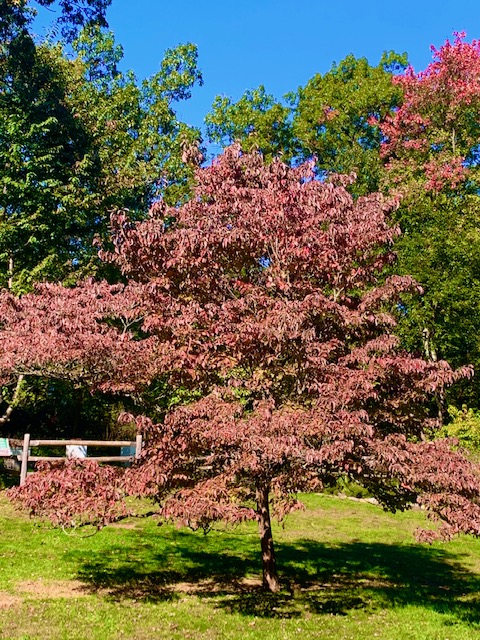
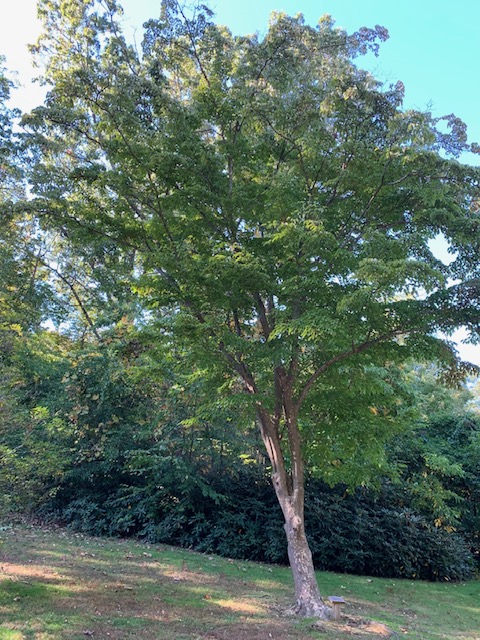
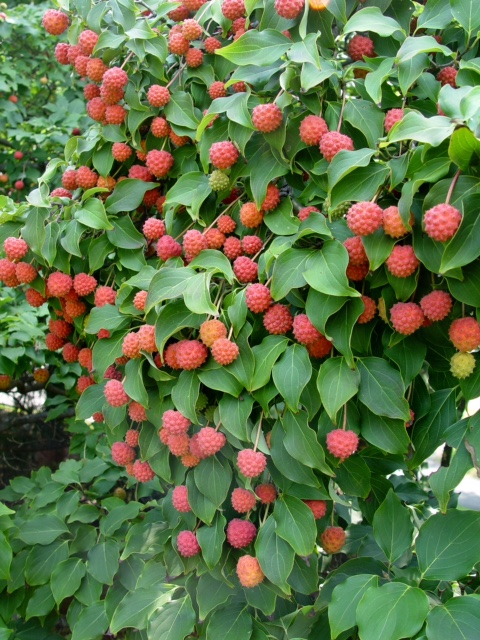
Plant species evolved together with animal species living in the same habitat. Flowering Dogwood evolved here, in Eastern North America, along with the insects, birds, and mammals native to our forests. Kousa dogwood evolved in Asia with the animals native there – very different animals.
Both species of dogwood have beautiful spring flowers, but the native Flowering Dogwood blooms weeks earlier – just as local pollinators emerge looking for nectar and pollen. Kousa dogwood blooms much later in the spring. By then, lots of other flowers have emerged and the need for early-season nectar and pollen is less crucial.
By the end of the season, the timing of these two species is reversed. Kousa dogwood produces its showy red berries early — in August. The berries of the Flowering Dogwood, on the other hand, start to ripen in October — just as songbirds need them to fuel their migration.
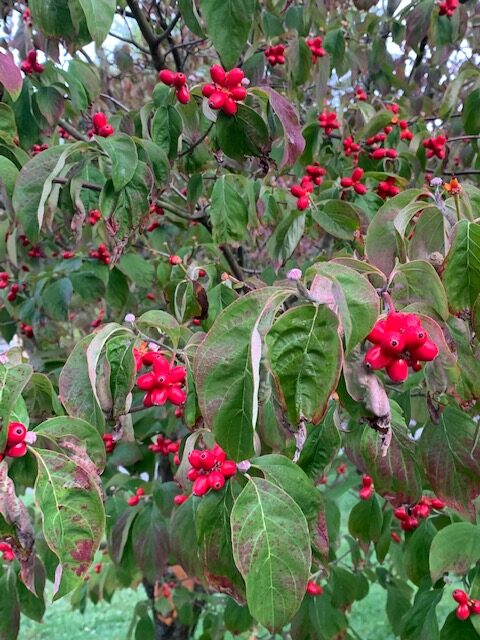
In Asia, Kousa berries are eaten by monkeys and other indigenous wildlife. Here, those berries are largely ignored. The berries are too big for songbirds. Squirrels and chipmunks aren’t interested either. Instead, Kousa berries end up where they fall, mashed by foot traffic and lawnmowers.
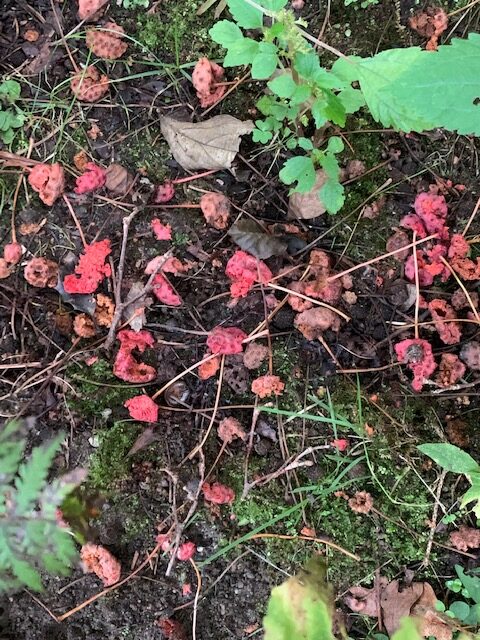
The berries of the Flowering Dogwood are an essential food source for migrating songbirds because they are full of nutritious fats and proteins. We have seen flocks of migrating birds descend on a Flowering Dogwood and clean it out of berries in a few days. Any berries that do hit the ground are quickly carried off by squirrels and chipmunks.

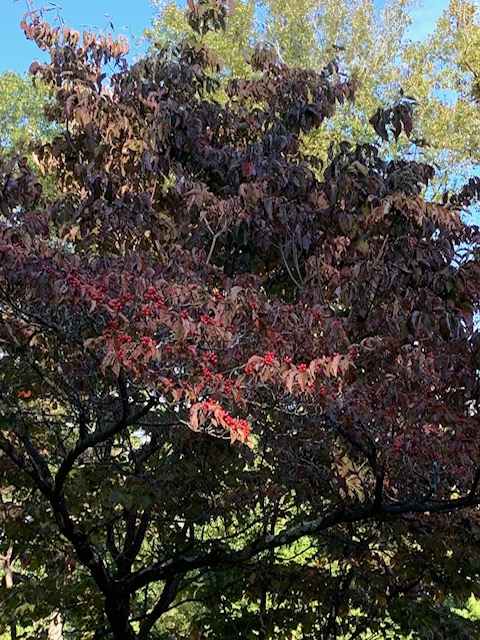
Nurseries and garden magazines may tell you that Kousa dogwood is a better choice for home landscapes than native dogwood because the Asian variety is more resistant to disease. The disease in question is anthracnose, a fungus that first appeared in the US in the 1970’s and quickly became lethal to native dogwoods. Research strongly suggests that the fungus actually was introduced to the US by importation of the Asian dogwood. Kousa dogwoods are more resistant to the fungus because they co-evolved with it and developed resistance over time. American dogwoods did not have that opportunity. The arrival of the fungus here was a near-disaster for this iconic American tree.
Fortunately, growers immediately began developing resistant varieties of Flowering Dogwood. “Appalachian Spring” was one of the first varieties to successfully fend off the disease. Other disease-resistant varieties are readily available now. “Cherokee Brave” and “Cherokee Chief” have pink flowers, while “Cherokee Princess” blooms in white. These trees do very well in our area. They prefer sun or part shade in well-drained soil, and benefit from organic fertilizer or compost. In periods of drought, they will need supplemental water. They never get too tall, and they make spectacular lawn trees.

If you’re looking for an ornamental tree with gorgeous spring flowers, great fall color, and an important role to play in the local ecology, skip the non-natives. You really can’t do better than Cornus florida, our own Flowering Dogwood.
This blog is authored weekly by Cathy Ludden, local expert and advocate for native plants and Board Member, Greenburgh Nature Center.

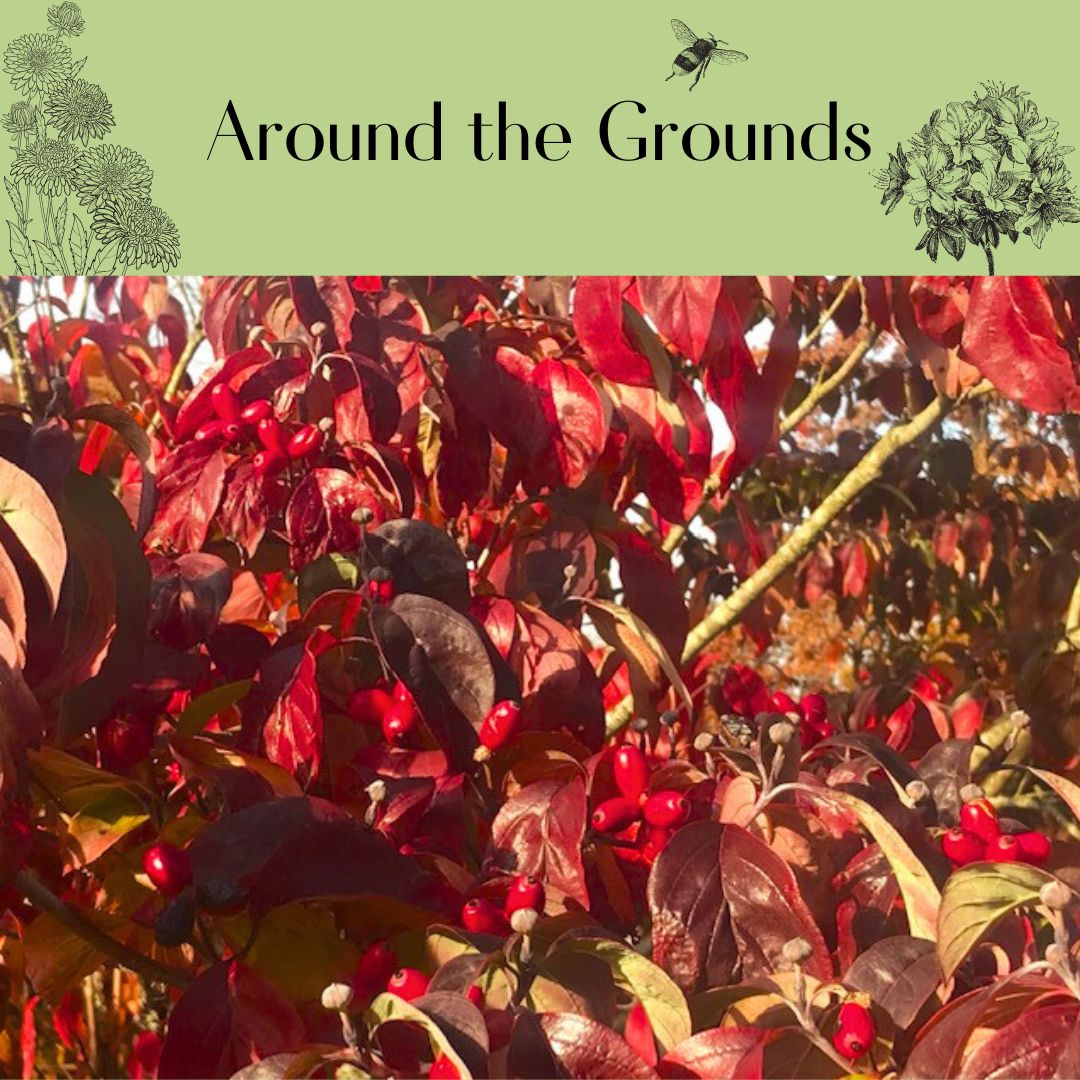
My woods are filled with native dogwoods & I am grateful. Had a couple die recently from no apparent reason. They were in close proximity to each other..
I get a lot of birds enjoying them – squirrels
You are lucky to have a woods filled with these beautiful trees. The deaths could just be old age. They are relatively short-lived trees, sadly. Just plant a few more of the disease-resistant selections!
my 65 year old native Dogwood died a slow death. I finally had to cut it down and saw that the inside of the trunk was completely hollow. There is some disease that is wiping out the native dogwoods. I have planted 2 more baby trees to make up for the one i had to cut down. Any advice for keeping them alive and healthy?
Truly, I’m sorry for your loss. I’ve been there, too. Two things to know: 1) dogwoods are short-lived trees and 50-70 years is their typical life expectancy, so yours had a good life; and 2) native dogwoods were attacked by a pathogen introduced on the Asian dogwoods (kousa). The non-native trees had evolved with resistance to the pathogen, but it hit American trees hard because they had not developed resistance. Your old tree may have been a victim, or not. In a desperate effort to save our beloved trees, horticulturists worked to produce more resistant American dogwood cultivars – and they succeeded! The “Cherokee” cultivars and others are doing very well. Most of the American dogwoods being sold now are disease resistant cultivars, so yours probably are. Still, they should be monitored for anthracnose. A qualified arborist can inspect them and if they need treatment, there are specialized sprays that work well. The chemical is like a fungicide and not very dangerous to insects, but the timing of the treatment matters for that reason. Ask a qualified arborist to check out your trees and get on a regular routine of inspection in the early spring and again in mid-season. It is totally worth the effort to have healthy American dogwoods!
Will those big red berries front the dogwood tree kill the yard??
They do kill the lawn under the Korean dogwood if we don’t get them raked up before they turn to mush. They make sort of a paste that sits on top of the grass. I find them to be a messy nuisance and they require extra work to keep the mess at bay. On the other hand, the berries from the American dogwood are harder and the birds clean them up right away.
We have both types of Dogwoods on our property in Rhode Island. The Kousa berries get cleaned out by the squirrels in the trees and other small rodents (rabbits, etc) once they hit the ground. We made jam from them once though it takes a LOT of berries as half the fruit are seeds. They taste a bit like an apricot and mango crossed together. Delicious, but too much work, so the squirrels stay fed.
Interesting! Squirrels here completely ignore them. They end up mashed into the ground. I wonder if it’s a learned behavior where you are? Maybe there is less other food? At least they reduce the clean-up for you!
It took a few years, but once they started they’ve continued to eat them for some 15 years now. The funniest thing is they tend to ferment if left a while in the heat, and we witnessed a squirrel fall out of the tree and just stayed on the ground where he landed, eating the ones that had fallen. I’m pretty sure he was intoxicated as he bobbed and weaved slowly across the yard!
Intoxicated squirrels! That’s pretty crazy. Do you notice seedlings develop from the Kousa seeds?
Yes, we have to remove dozens of seedlings every year.
Another informative and enjoyable post!
I love learning from your blogs Cathy. This is great information.
Thanks for the support, Tracey!
Love your blogs! You gave a great explanation of the dogwood that I have in my front yard….the Kousa variety, planted by Al Krautter years ago. I could never figure out why critters never seemed to want the big red berries, but now I get it.
Thanks for the information! It is very helpful.
I’ve had the same experience, Jim. I’ve seen birds peck at the berries, but then leave them on the tree. Now, if we only had a monkey…
This is great. It was interesting to learn about the timing of the berries and how this relates to the areas in which the dogwoods developed (native vs. Asia)!
I agree. I was interested to discover that the big Kousa berries support monkeys in their native range — not so useful here!
Wonderful post! Always learning!
What about red osier dogwoods? I think they’re also called red twig dogwoods. Native?
Yes! Red osier is native and gorgeous! I will write about it soon — ours at the nature center is just now dropping leaves and starting to show off it’s winter colors. Thanks for asking!
Its, not it’s! Autocorrect!
Appreciate the interesting and important information!